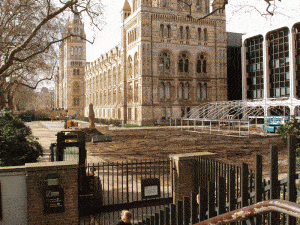Support us from £3/month
We deal with almost 1000 cases a year assisting communities, groups and individuals in protecting their local spaces and paths in all parts of England and Wales. Can you help us by joining as a member?
We have backed our member the Kensington Society and other local societies(1) in calling for the council’s planning guidance to recognise the land surrounding the Natural History Museum as a local green space that is open to the public.

The lawns, photographed by a member of the Kensington Society in early 2011, are in the same state in early 2012 after the whole area had been covered to allow for temporary structures and vehicles.
We sent the Royal Borough of Kensington and Chelsea a strong submission that the council’s Supplementary Planning Document must recognise the East Grounds, and in particular the East Lawn, at the Natural History Museum as local green space.
It is vital that this important and popular land is given the recognition it deserves as green space. This neighbourhood lacks open space for the enjoyment of local people, office workers and visitors, and the green lungs around the Natural History Museum and the other Kensington museums fulfil a vital function.
Says Michael Bach of the Kensington Society: ‘The Council’s proposed planning guidelines fail to understand the important role of the East Grounds, and especially the East Lawn, not just as an important part of the setting for the Natural History Museum, but as a vital local green space—the only one open to the public in this densely built-up area.
‘The museum has, over the last six years, increasingly used the East Lawn and East Grounds for “temporary” commercial events, often back to back, so that this green space is not freely open to the public for a very large part of the year, after which the lawns may be damaged and need to recover or even be returfed. We asked the council to use the guidelines to manage the scale, frequency and, above all, the duration of these temporary events—it has not done so.
‘The museum is now considering paving over this vital local green space. The loss of this space, by paving it and then using it more intensively, amounts to the effective loss of this publicly-accessible open space,’ says Michael.
1. The objections to the Royal Borough of Kensington and Chelsea’s proposed Supplementary Planning Document on the Natural History Museum Grounds Design Guidance were coordinated by the Kensington Society on behalf of the Brompton Association, Earl’s Court Society, Knightsbridge Association and Onslow Neighbourhood Association.
